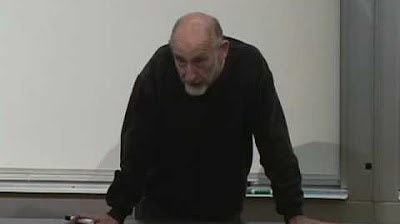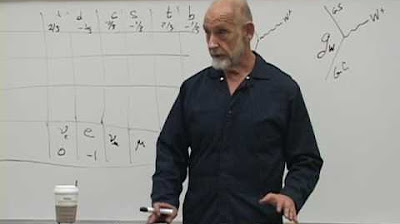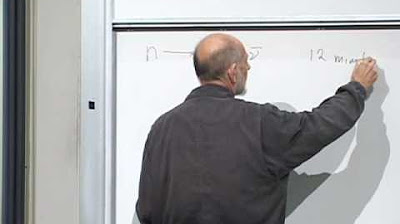Lecture 2 | New Revolutions in Particle Physics: Standard Model
TLDRThe video script offers an insightful lecture on quantum chromodynamics (QCD), a theory that describes the interactions between quarks and gluons, which are the fundamental particles that make up protons, neutrons, and other hadrons. The lecturer emphasizes that while QCD shares similarities with quantum electrodynamics, it introduces the concept of color charge, which is a key property of quarks and gluons, allowing for a more complex theory where gluons can interact with each other, unlike photons. The script delves into the mathematics of spin, the concept of isotopic spin, and the historical development leading to the discovery of quarks and the formulation of QCD. It also touches upon the properties of quarks and gluons, including their mass and charge, and the implications of these properties for the structure and behavior of hadrons. The lecturer highlights the importance of symmetry and conservation laws in understanding the underlying principles of particle physics.
Takeaways
- 🚩 Quantum Chromodynamics (QCD) is the theory of quarks and gluons, which are the building blocks of hadrons like protons and neutrons.
- 🌀 QCD is similar to Quantum Electrodynamics (QED), which deals with electrons and photons, but it also includes the strong force that holds quarks together.
- ⚫ The concept of 'color charge' in QCD is analogous to electric charge in QED and is a fundamental property of quarks and gluons.
- 🔵 Quarks come in three 'colors' (red, green, blue), and antiquarks have corresponding anticolors, which is a key aspect of their interactions.
- 📈 The mathematics of spin is crucial for understanding the behavior of particles in QCD, as it is for particles in QED.
- 🧲 Gluons are the mediators of the strong force in QCD, analogous to how photons mediate the electromagnetic force in QED.
- ➿ Gluons can interact with each other, which is a unique feature of QCD not found in QED, leading to self-interactions and complexity in particle interactions.
- 🤔 The mass of quarks, as observed, is dependent on the frequency of the force applied to them, which is a concept that requires careful definition in quantum field theory.
- 🚀 The discovery of quarks and the development of QCD involved a combination of experimental evidence and theoretical insights from multiple physicists over time.
- 🤓 The properties of quarks and gluons, such as their mass and charge, are defined within the framework of quantum field theory and are subject to 'running' with respect to the energy scale of interactions.
- 🧬 QCD is a cornerstone of the Standard Model of particle physics, describing the strong interactions that hold the nucleus of atoms together.
Q & A
What is Quantum Chromodynamics (QCD)?
-Quantum Chromodynamics (QCD) is the theory of quarks and gluons, which are the fundamental particles that make up hadrons, such as protons and neutrons. It is similar to Quantum Electrodynamics (QED), which deals with electrons and photons, but QCD describes the strong force that holds quarks together in these particles.
What is the role of gluons in Quantum Chromodynamics?
-Gluons are the force carriers in Quantum Chromodynamics. They are the 'glue' that holds quarks together within hadrons. Unlike photons, which are the force carriers in electromagnetism, gluons can also interact with each other, leading to a complex and rich theory.
What is the significance of the term 'color' in the context of Quantum Chromodynamics?
-In QCD, 'color' is a label for a property of quarks, similar to charge in electromagnetism. It is not related to visual color but refers to a type of charge under the strong force. Quarks come in three 'colors', and the theory requires that quarks within a hadron are always in a color-neutral combination, such as one of each color.
What is the difference between baryons and mesons in terms of quark composition?
-Baryons are hadrons made up of three quarks, such as protons and neutrons. They have a net baryon number, which means an imbalance of quarks and antiquarks. Mesons, on the other hand, are composed of a quark and an antiquark pair. Both baryons and mesons are held together by gluons.
How does the mathematics of spin relate to Quantum Chromodynamics?
-The mathematics of spin is foundational for understanding the symmetries and transformations in particle physics. In QCD, the concept of 'color' is analogous to the concept of spin in quantum mechanics, providing a framework for the internal symmetries of quarks.
What is the principle that led to the discovery of color in quarks?
-The principle that led to the discovery of color in quarks is the Pauli Exclusion Principle, which states that no two fermions can occupy the same quantum state simultaneously. The existence of the Delta particle, which contains three identical quarks, violated this principle, leading to the realization that quarks must have an additional degree of freedom, which is now known as color.
What are the properties of gluons that make them different from photons?
-Gluons are similar to photons in that they are massless and have a spin of one. However, gluons have a key difference: they can interact with each other. This self-interaction property is what allows gluons to bind together and form composite objects, unlike photons, which do not interact with each other directly.
How does the concept of isotopic spin relate to the up and down quarks?
-Isotopic spin is an internal quantum number that arose in particle physics as an analogy to the concept of spin. It relates to the interchange of up and down quarks. In the context of isotopic spin, up and down quarks are considered symmetrical, much like spin-up and spin-down states in the theory of spin.
What is the significance of the Delta particle in the development of Quantum Chromodynamics?
-The Delta particle, also known as Delta baryon, played a crucial role in the development of QCD. It contains three identical quarks, which seemed to violate the Pauli Exclusion Principle. This led to the realization that quarks must have an additional property, known as color, allowing them to exist in three different states and thus avoid the violation.
How does the mass of a quark manifest differently under high and low frequency forces?
-The mass of a quark is frequency-dependent. Under a low-frequency force, the entire hadron, which includes the quark and the surrounding gluons, moves together, and the mass felt is that of the whole hadron. Under a high-frequency force, only the quark itself responds, and the mass felt is the intrinsic mass of the quark, which is much less than the mass of the hadron it is part of.
What is the role of the strong force in holding particles together within a hadron?
-The strong force, mediated by the exchange of gluons, is responsible for holding quarks together within hadrons. This force is so powerful that quarks are never found alone in nature; they are always confined within composite particles like protons, neutrons, and other hadrons.
Outlines
📚 Introduction to Quantum Chromodynamics
The video begins with an introduction to quantum chromodynamics (QCD), emphasizing its significance alongside quantum electrodynamics (QED). QCD, the theory of quarks and gluons, is likened to QED, which deals with electrons and photons. The lecturer plans to focus on the fundamental concepts rather than delving into complex mathematics, aiming to provide an intuitive understanding of QCD. The importance of angular momentum and the concept of 'color' in quantum physics are also introduced, with a reminder of the mathematical principles from a previous lecture.
🌀 The Symmetry and Mathematics of Spin
The lecturer delves into the mathematical description of spin, highlighting its importance in quantum physics. Spin is a form of angular momentum intrinsic to particles, and the lecturer discusses how different components of spin do not commute with each other, leading to the focus on one component at a time. The concept of quantization of angular momentum is introduced, and the lecturer explains the different possibilities for spin states, including fermions with half-integer spin and bosons with integer spin. The relationship between the maximum value of spin and the number of independent states is also explored.
🤝 Combining Spins and Particle States
The video segment discusses how the spins of multiple particles, such as electrons, can be combined to create new states of angular momentum. The focus is on the combinations of two electron spins and the resulting spin states, which can range from a maximum of one (when spins are aligned) to a minimum of zero (when spins are anti-aligned). The concept of symmetric and antisymmetric states is introduced, and the lecturer explains how these combinations relate to the total spin of the system.
🚴♂️ Isotopic Spin and Its Relation to Quarks
The lecturer introduces the concept of isotopic spin, an internal quantum number that, like spin, does not pertain to the rotation of space but to an internal space. Isotopic spin is used to describe the symmetry between up and down quarks, which are light and have similar properties. The video explains how the masses of up and down quarks are nearly equal, creating an approximate symmetry, and how this symmetry is broken by the electric charge difference. The historical context of isotopic spin's discovery and its relation to particle physics is also provided.
🧠 The Concept of Color in Quantum Chromodynamics
The video explores the concept of color in QCD, which is a label for a property of quarks that allows three identical quarks to coexist within a particle, such as a Delta baryon, without violating the Pauli exclusion principle. The color charge is a fundamental aspect of QCD, and the lecturer explains that quarks come in three colors—red, green, and blue—and that this color charge is analogous to the three possible spin states. The importance of color in maintaining the validity of the quantum model of quarks is emphasized.
🔵 Gluons and Their Interactions in QCD
The segment discusses gluons, the force carriers in QCD, which are analogous to photons in QED. Gluons have the unique property of being able to interact with each other, a feature not present in photons. The lecturer explains how gluons can be thought of as a combination of a quark and an antiquark and how they can emit other gluons, leading to self-interaction. The video also touches on the nonlinear dynamics of gluons and the resulting complex behavior in QCD.
🔍 The Ambiguity of Quark Mass
The lecturer addresses the ambiguity surrounding the concept of quark mass. Depending on the frequency of the force applied to a quark, the observed mass can vary. At low frequencies, the mass observed would be that of the entire hadron containing the quark, while at high frequencies, the mass observed would be closer to the intrinsic mass of the quark itself. The idea that particle parameters, such as mass and charge, are dependent on the frequency and wavelength of interactions is introduced, highlighting the complex nature of quantum field theory.
🌟 Conclusion and Historical Notes
The video concludes with a brief mention of the historical development of quark theory, acknowledging the collective effort of various scientists in establishing the concept of quarks. The lecturer also hints at the topic of confinement of quarks, which will be discussed in subsequent lectures, and the overall structure of hadrons. The video ends with an invitation to learn more through the provided educational resources.
Mindmap
Keywords
💡Quantum Chromodynamics
💡Quarks
💡Gluons
💡Color Charge
💡Isospin
💡
💡Confinement
💡Hadrons
💡Pions
💡Spin
💡Fermions
Highlights
Quantum Chromodynamics (QCD) is the theory of quarks and gluons, which are the fundamental particles that make up hadrons such as protons and neutrons.
Gluons are the force carriers in QCD, analogous to the role of photons in Quantum Electrodynamics (QED).
Quarks and gluons are held together by the strong nuclear force, which is mediated by gluons.
The theory of spin and angular momentum is foundational to understanding the behavior of quarks and gluons.
Quantization of angular momentum and the concept of multiplets arise from the mathematics of spin.
Fermions, such as quarks, have half-integer spin, while bosons, like photons, have integer spin.
The combination of two electron spins can result in a total spin of either 1 (triplet state) or 0 (singlet state).
Isospin is an internal quantum number that is analogous to spin but relates to the interchange of different types of quarks.
The up and down quarks are lightest and have nearly the same mass, leading to an approximate symmetry between them.
Baryons, such as protons and neutrons, are composed of three quarks and carry a baryon number.
Mesons are composed of a quark and an antiquark, and are lighter than baryons.
The concept of color charge was introduced to explain why three quarks could form a baryon without violating the Pauli exclusion principle.
Each type of quark (up, down, charm, strange, top, bottom) comes in three colors, providing a way to distinguish between quarks in a baryon.
Gluons can interact with each other, unlike photons, which leads to the possibility of gluon-gluon interactions and the formation of glueballs.
The mass of a quark or gluon is not well-defined and can depend on the frequency of the force applied to it.
Quantum Chromodynamics is a highly accurate description of experimental data from particle collisions and is a fundamental part of the Standard Model of particle physics.
Transcripts
Browse More Related Video
5.0 / 5 (0 votes)
Thanks for rating:





